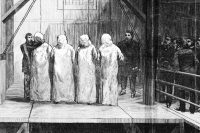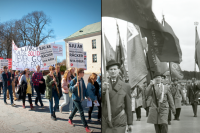
The Finnish trade union movement is re-emerging at the centre of economic and social policy preparation, writes Esa Suominen.
The first anniversary of the Finnish six-pack coalition and the return of the Social Democrats to the government is approaching. This first year has seen major decisions taking place, especially when it comes to the economy, the labour market and European policies. But what is even more relevant is the re-emergence of the Finnish trade union movement at the centre of economic and social policy preparation.
In previous years, pension policy and retirement age questions have dominated the Finnish social policy debate. Traditionally these issues have been prepared and adopted by tripartite cooperation between state, employers and trade unions. This was the case when Finland last renewed its pension system in 2005, when the lowest age of retirement was lowered to 63 years, but at the same time significant incentives were created to encourage individuals to voluntarily prolong their careers to 68 years. The result was a flexible work-leaving age, which was accompanied with a pact on the future of pension contributions and the introduction of other reforms such as a life expectancy coefficient which encourages – or effectively forces – younger generations to stay longer in the labour market.
This tripartite cooperation suffered a serious rupture when the previous right-wing government, under Prime Minister Matti Vanhanen from the Centre Party, unilaterally declared that the lowest retirement age should be lifted to 65 years. This maneuver quickly froze the relations between trade unions and the government. Although the government retreated and handed down the issue to be negotiated with the social partners, mistrust ran deep.
After the Centre Party suffered defeat in the 2011 general election, the trade union movement has made a significant comeback to the tables where decisions are made. First the new government urged the social partners to negotiate a major pact concerning salary policy for the future. The so-called frame treaty, which gives guidelines for different sectors on the future costs of labor, was signed between the main confederations and then adjusted in union level negotiations. This new model of a nation-wide treaty was achieved, although the employer side had previously stated that the era of cross-sector collective agreements would be over.
The frame treaty was followed by a tripartite deal concerning future funding of pensions and the prolongment of careers. A whole package of activities is expected to raise the effective age of retirement by one year. One important innovation, which was also agreed upon, is the so-called youth guarantee, which makes sure that every young person leaving school will receive a place in employment, education or training.
***
The next occasion in which a similar kind of “working class comeback” can be seen, will be the SDP congress in May. There will be no candidate to challenge the current party leader Jutta Urpilainen, but on the lower levels the ground is shaking.
Positions of all three vice-presidents and the party secretary general will be contested, and it is likely that all incumbent vice-presidents will face strong challenges. Since the party congress in 2007 the leadership of the party has faced criticism retarding their visibility and the degree to which they are ‘in touch’ with the party’s more traditional and grassroots, salaried workers. It would now seem likely that the Congress will opt for more “traditional-looking” and sounding politicians.
The hunt for “something more familiar” can be seen also in the quest for a new Secretary General. The incumbent, Mikael Jungner, who was elected two years ago with great expectations after his politically motivated removal from his job as the CEO of the Finnish public broadcasting company YLE, is voluntarily standing down. He has publically stated that the reason is the SDP’s poor performance in the last presidential elections. Other sources claim though, that the tensions between him and the local level had grown so strong, that it would have been hard for him to continue.
It is obvious that although SDP is in a need of a lot of work in the improvement of its policies and the development of a distinct ideological vision for the future, this discussion has so far been in practice non-existent. The new party leadership will also need ways of improving the content of the SDP’s core messages of work and social justice in the October local elections. Mere organizational attention will not be enough.
Esa Suominen, Director of Administration, Special Advisor to the President. Finnish Service Union United PAM
Följ Dagens Arena på Facebook och Twitter, och prenumerera på vårt nyhetsbrev för att ta del av granskande journalistik, nyheter, opinion och fördjupning.


































